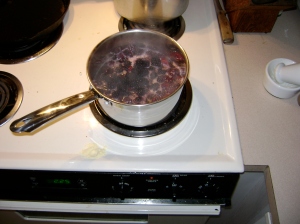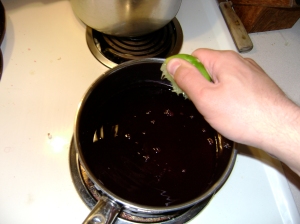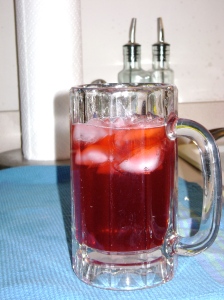For as long as I can remember, one of the best things about going to visit grandma was the jar of homemade sand plum jelly. When my grandpa was alive, he would pick the plums. When he passed away (about 10 years ag0), that fell on us. If we wanted jelly, we had to pick the plums. Unfortunately, I no longer live in Oklahoma, where sand plums run amok. So it’s no longer practical for me to pick plums to give to grandma (and I also live much farther away). Which means no more homemade jelly… unless…
I always thought that jelly/jam making was some magical process which you had to be at least 60 years old to understand. I guess it’s because I’ve never known anyone to make it who wasn’t a grandma. Come to think of it, I’ve never known anyone to make it who wasn’t MY grandma. So I just assumed it was difficult, time consuming and mysterious. Then I decided to look it up.
Pretty easy. There’s some specialized equipment that you need if you’re going to preserve your jam (and unless you’re going to eat it all within a month, you should), but by and large, it’s pretty easy. The first thing you’re going to need, of course, is jars (with two-piece lids). I bought a dozen for $8.50. Those jars will come with lids, but those lids can only be used once (assuming you’re going to preserve your jelly/jam). (The rings can be used again, but the sealing part of the lid must be replaced.) So if you have some old jars laying around (like I did), you’ll need to buy some more lids to go with them ($2 for a dozen). Also, you’ll need a canning funnel. This is a wide-mouthed funnel which perfectly fits into the mouth of a canning jar. You could try to ladle your jam/jelly right in, but if you get any on the edges of the jar it won’t seal (or you’ll have to wipe it away, which can ruin your sterilization). Also, a jar holder comes in verrrrrry handy. You can do it without (I did), but I don’t recommend it. Also, a lid lifter (a magnet on the end of a long stick) is handy, but I didn’t have any trouble picking up my lids with a pair of tongs.
You’re also going to need a big, deep pot. You can also buy a canning kettle (which comes with a wire jar rack – which is handy), but they’re unnecessary as long as you have a deep enough stock pot to cover the jars.
Okay, let’s begin!
You’ll need:
enough berries to make 5 crushed cups (about 2.5 – 3 lbs)
1 package of fruit pectin
7 cups of sugar
Note: If you’re making anything other than blackberry jam, just follow the directions inside the pectin box. They’ll tell you how much of everything you need. You may also need some lemon juice, depending on the acidity of whatever you’re making jam out of.
Now… First thing’s first. Wash everything. If it’s even going to think about coming in contact with your jam, wash it. Jars, lids, tools, the works. Meanwhile, in a pot big enough to hold everything (or two pots, in my case), boil enough water to cover all your jars/tools/etc. Add everything but the lids (the sealing part) to the boiling water and boil for at least 10 minutes (longer at higher elevations). When the water has boiled for that long, kill the heat. Let the water cool down to 160° or so (5-10 minutes) and add your lids. If you add the lids while the water is still boiling hot, it will ruin the sealing compound.
While your tools and jars are boiling, rise enough berries to make 5 crushed cups (about 8 cups of whole berries) and add them to a deep stockpot (you can use this same pot later on for preserving your jam, you’ll just have to wash it out first) over high heat. With a potato masher, crush the berries very thoroughly. When the berries have been thoroughly crushed, stir in one box of fruit pectin and bring mixture to a roaring boil over high heat. When the berries are at a full boil, add in 7 cups of sugar. Stir and quickly return to a boil and boil for 1 minute. Remove from heat.
One at a time, remove your jars from their water bath and quickly ladle the mixture into them, using the canning funnel. Without touching anything that contacts the fruit with your bare hands, add the lids to the jars and screw the rings on until they just begin to tighten.
Once all of your jars are filled, add them to your canning pot (if you’re using the same pot you just cooked the berries in, then wash it very quickly and fill it with the leftover water from your sterilization pot). Place a tea towel in the bottom of the pot (so the jars don’t rattle) and align your jars in the pot. Bring quickly to a full boil and boil for 10 minutes (longer at higher elevations).
Carefully remove the jars from the water and allow them to set, undisturbed, at room temperature for 12 to 24 hours. If the jars are properly processed, the lids should “pop” down and remain in the down position until they are opened. If any lid doesn’t “pop” down, then just eat that jar within a month or so and it should be fine…
Now, what to put it on… That’s a post for another day (check back soon)…












